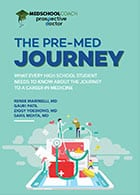
Table of Contents
The primary difference between medical school and residency can be best summarized as this: one is defined by teaching, the other is training.
In medical school, you take classes, pay tuition, and learn the necessary knowledge and skills to succeed in the medical field. In residency, you put the knowledge you learned in school to use in your chosen specialty and earn money while doing it.
Residents practice medicine, and though there’s still quite a bit of supervision during residency training, this will be the first time in your medical career that you’ll experience what it means to be a doctor.
I describe these in greater detail below, but this chart breaks down the basic differences to expect between medical school and a residency program.
| Medical School | Residency | |
| Application Process | Medical students apply via AMCAS (MD programs), AACOMAS (DO programs), or TMDSAS (most TX medical programs) | Fourth-year med students apply to residency at the beginning of the school year, complete interviews, and then get paired with a residency program on Match Day (in March) |
| Duration | 3-4 years | 3-8 years, depending on specialization |
| Structure | 2 years of preclinical education, followed by 2 years of clinical rotations/clerkships | Varies by program; generally begins with significant supervision during PGY-1 (or your ‘intern year’), followed by progressively increased autonomy and responsibility |
| Grading | Varies by program, but most medical programs have transitioned to some form of pass/fail; some medical schools have a straightforward P/F system, while others add “Honors” and “High Pass” to distinguish performance | Residencies have no formal grading system; residents are judged based on job performance according to ACGME core competencies via ongoing self- and faculty evaluations |
| Testing | First 2 licensure exams (USMLE for MD students and COMLEX for DO students) — Step 1/Level 1 after your second year and Step 2 CK/Level 2 during your third or fourth year; NBME shelf exams at the end of each clerkship; you’ll also need to take the MCAT prior to applying to medical school. | USMLE Step 3/COMLEX Level 3 after the first year of residency training; In-training exams (ITEs) based on specialty; Specialty-specific board exams at the conclusion of residency (not required but essential for most doctors) |
| Finances | Around $236,000 average tuition for all 4 years; the workload does not allow time for most students to hold an additional job while in school | Average salary of $63,800 for PGY-1; residency salaries increase each PGY and are standardized by each healthcare system, primarily based on cost of living (no pay difference based on specialty). Senior residents may be selected for chief resident, which typically offers slightly more pay than their same-year counterparts. |
Let’s look at the major differences between going to medical school and completing residency so you know what to expect during and after this transition.
Application Process
You’ll notice a lot of overlap in what’s required for the residency application process (The Match) compared to your medical school applications, like standardized test scores, a personal statement, and interviews.
However, it’s quite a different experience in several ways, not least of which because you’re applying for a job versus a position as a student. AdComs for medical schools are looking for students likely to excel in the career path in the first place, while residency program directors are seeking entry-level physicians who are a good fit for their specific specialty and the mission of their program.
You can read more about the medical school application process and The Match in our comprehensive guides, but here are the key differences to be aware of:
- Residency applicants have a far higher chance at success than medical school applicants. The average medical school acceptance rate is roughly 42-44% in any given year, meaning fewer than half of all applicants matriculate to a medical program. Conversely, the Match rate for all residency positions offered is over 90%. By the time you graduate from medical school, you no longer have to prove whether or not you’ll be able to make it as a doctor — it’s more about connecting your experience with the right specialty and specific program.
- Residency applicants are matched to a single program, while successful med school applicants can choose from multiple acceptances. Before Match Day, residency applicants are required to submit a list of the programs they interviewed at in order of preference, while programs are required to submit a preference list for applicants they interviewed. Each applicant is then assigned to a single program based on both sets of preferences according to the Match algorithm. Residency applicants are contractually obligated to attend the residency program to which they are matched. Medical schools, by contrast, simply accept or reject applicants, so those with multiple acceptances decide where to enroll.
- A significant part of the residency application process is choosing to apply to one or more specialties, whereas medical school applicants are all applying for the same graduate program. The four years you spend in medical school are some of the most important for choosing exactly what kind of doctor of medicine you want to be. When filling out the ERAS and later creating your rank order list, you’ll have to make decisions like whether or not you’re interested in a competitive specialty, if you’re looking for a shorter residency period, like with a primary care focus, or if you’ll try alternating specialties vs. your top choice specialty first.
- The Match allows partners to apply for residency positions in similar geographic locations; primary med school applications do not. If you’re interested in attending the same medical school as your partner, you’ll both have to apply separately. However, the Couples Match allows for this if you want to live with or near your significant other when starting out in actual medical practice.
Duration
Most medical programs last 4 years, though some accelerated medical schools give you the chance to become a medical school graduate in just 3 years. Dual-degree programs can take longer — for instance, most MD/PhD programs last 7-8 years, while MD/MBA and MD/MPH programs add one year to the typical four-year timeline of medical school.
Residency programs last for between 3-8 years. More years of training are generally required for more complex specialties, like surgery (which requires a minimum of 5 years in residency). Family medicine and pediatrics residencies are almost always 3 years long, whereas a plastic surgery residency lasts an average of 6 years.
Some subspecialties, such as neurosurgery, max out the full 7-8 years of residency.
Different specialties may require or allow you to try for a preliminary residency program, which lasts 1-2 years and is then followed by an advanced residency for 2+ more years. This is more common in specialties like surgery, neurology, radiology, anesthesiology, and dermatology. In these cases, you’ll need to apply to both the preliminary (or transitional) and advanced programs at the same time, making the application process a bit more expensive and complex.
Depending on the type of subspecialty you wish to pursue, you may also move into a fellowship program (generally 1-3 years) after residency. While these are still technically training programs, fellowships do not require stringent supervision in the same way the early years of residency might.
Structure
The structure of a four-year med school typically follows this format:
- Preclinical (Years 1 & 2): During your first year of medical school, you learn the scientific foundations of medicine to prepare you for a career as a physician. Year two focuses on classroom learning on pathophysiology and clinical preparation.
- Clinical (Years 3 & 4): In year three of medical school, you complete core clinical rotations in major medical specialties, including internal medicine, surgery, pediatrics, psychiatry, obstetrics/gynecology, and family medicine. During year four, you’ll explore your interests or subspecialties in elective rotations. While you get to do hands-on patient care during these rotations, your responsibilities will be limited (e.g., you can’t diagnose conditions or develop treatment plans).
Residency is less structured than medical school, as a medical residency program bridges the period between your formal education and independent clinical practice. However, all residents experience some degree of the following:
- Progressive Responsibility: The longer you are a resident and the more you prove your competence, the more complex and autonomous your responsibilities become.
- Rotational Training: During your residency, you’ll receive medical training in various subspecialties related to your broader field. For instance, an anesthesiology resident will likely do rotations in pediatric anesthesiology, neuroanesthesiology, and obstetric anesthesiology (among others). These subspecialty rotations are ultimately designed to help you choose the precise branch of medicine that fits you best.
- Didactic Education: Residents go through regular educational sessions, including grand rounds, morbidity and mortality conferences (M&Ms), and specialty-specific lectures, to learn more about their field and assess how to improve patient care.
- Evaluation: As a resident, you’ll consistently be required to self-evaluate and receive assessments from faculty members overseeing your training. These evaluations play a large part in the progressive responsibility you are given as you learn.
Read Next: Average Residency Applications Per Specialty
Testing
Prior to medical school, you must pass the MCAT (in almost every case), which assesses problem-solving and knowledge related to the medical field that you need to succeed in the early years of a medical program.
Medical students are also required to take a number of standardized exams throughout their education, including:
- USMLE Step 1/COMLEX Level 1: The first licensure exam evaluates whether students can integrate and apply foundational science knowledge to clinical scenarios. Note: As of January 2022, Step 1 is graded as pass/fail only.
- Shelf Exams: The NBME shelf exams are given at the end of each clinical clerkship (typically your third year of med school) to assess how well you understand the core disciplines of each specialty you rotate through.
- USMLE Step 2 CK/COMLEX Level 2: The second licensure exam tests your knowledge of clinical sciences and the application of that medical knowledge in patient care. Most medical students take Step 2/Level 2 during their fourth year, and this numeric grade is used as a vital part of the residency application process.
As you can see, there are two variations for licensure exams based on whether you’re in a medical program to become an MD or a DO. However, the basics of what these exams test and how are very similar.
Residents also complete testing as part of their medical training, which includes:
- USMLE Step 3: After completing the intern year, residents take their third licensure exam, focusing on patient management, diagnosis, and clinical decision-making. Passing Step 3/Level 3 is required to become a fully licensed physician — you’ll be a doctor after finishing medical school, but you can’t practice independently until now.
- In-Service or In-Training Exams (ITEs): Each resident will complete annual ITEs according to their specialty to assess their progress in training. These can influence applying to fellowships and remediation decisions (meaning what happens if you perform poorly on future ITEs or your board exams). ITEs are designed around your specialty; for instance, there are different exams for students in an internal medicine residency vs. family medicine or obstetrics.
- Board Certification Exams: At the conclusion of your residency training, you’ll take board exams for your specialty. Technically, these are voluntary exams not required to practice medicine in general; however, they greatly influence where you’ll be able to work and whether or not you’ll qualify for insurance payouts from patient care. Think of these as voluntary but essential in most cases. If you want to practice in multiple or combined specialties, you’ll need to take all of the required certification exams.
97% of our residency clients match into one of their top-choice specialties. Let us help you excel in The Match from start to finish.
Cost and Financial Considerations
Medical students typically accrue debt to complete their education, whereas residents make a salary while training (although not like what they’ll get after residency).
The average medical school tuition is $235,827 for a four-year medical degree. While in medical school, most students cannot hold jobs while keeping up with the demands of study and rotations. This means you’ll need to have a way to provide for basic needs during your years of medical school.
Residency, on the other hand, does pay a salary. The first-year resident salary currently averages $63,800, and this standardized rate increases for each year of residency. There are no salary differences between residents in varying specialties, and the rates are set by hospital/healthcare systems based mostly on the local cost of living.
Fully licensed and board-certified doctors begin to make an expected physician’s salary after completing residency. It’s at this point that most doctors begin making a much more significant dent in their medical school debt.
The Transition Process
Transitioning from medical school to residency can seem challenging at times because you’re going from theory to practice.
Up until now, everything you learned was academic or in a heavily supervised setting. You were expected to know the basics about diseases, treatments, and potential complications. You took notes, observed procedures, participated in clinicals, and were grilled by attendings. Then, you graduate, and it’s time to put everything into action.
When you enter residency, patients count on you to take care of them. As a resident physician, you’re not just demonstrating your knowledge; you’re putting it to work in the field.
As you gain experience, though, you’ll gain confidence. In your first year of residency, you’ll sharpen your clinical skills, grow in patient care and professionalism, and begin to thrive in your environment.
Here’s a short breakdown of what you can expect when you start your journey as a resident:
- Beginning residency: Your first week of residency will kick off with orientation. You’ll meet fellow interns, receive your official MD badge, and review hospital policies, safety protocols, and work expectations. You’ll also be assigned to a medical team by the end of the week.
- Daily rounds: Most days, you’ll start bright and early at 7 AM with patient care check-ins before joining your team for rounds. These rounds are led by an attending or teaching physician. You and your team will visit each patient and discuss treatment and how the patient is progressing.
- After team rounds: After rounds with your team, you’ll spend the day managing patient care, writing orders, coordinating with nurses, and handling admissions – including taking patient histories and performing exams.
- Ending your shift: At the end of your shift, you sign out, and the team that’s on call takes over. Signing out includes updating your replacements with pertinent information about each patient.
Beginning residency isn’t always easy, but it will be exciting. You’ll be treating real patients, having input into treatment options, and developing relationships with patients and your medical team.
The transition from med school is a learning curve, but it’s also the moment you get to start growing into the physician you’ve worked so hard to become.
FAQs
If you don’t match into a residency on Match Day, you may be eligible for SOAP (Supplemental Offer and Acceptance Program). SOAP helps applicants apply to unfilled residency positions during Match Week.
To be eligible for SOAP, you must be unmatched, registered in the main match through the National Resident Matching Program (NRMP), and available to start residency in June. Once you find out you’re unmatched on Monday, you can apply to residency programs you qualify for through Thursday. You will find out on Friday of Match week if you’ve been accepted.
If you’re still unmatched after SOAP, you can contact programs directly until May 1 or consider reapplying in the next cycle.
Related: Categorical vs Preliminary vs Advanced Residency Programs
To become a licensed physician in the U.S., you must complete several milestone steps, including earning a bachelor’s degree with pre-med requirements, taking and passing the MCAT, and graduating from an accredited MD or DO program.
After medical school, you enter post-graduate training through a residency program accredited by the Accreditation Council for Graduate Medical Education (ACGME).
During residency, you must pass the remaining steps of the USMLE or COMLEX exams to qualify for medical licensure. Once licensed, many physicians go on to become board-certified in a specialty by passing additional board exams and evaluations.
The roles of med students and residents largely overlap, as the two share many responsibilities and jobs.
The primary difference between them is their level of autonomy. Medical students are subject to constant supervision during their clinical years while they are still learning, while residents are given increasing independence throughout their residency as they become more competent in their profession.
Medical students can assist with patient care but are not allowed to diagnose conditions, develop treatment plans, or prescribe medication. Residents can do all of these under the supervision of senior residents and attending physicians.
The levels of doctors in hospitals, beginning with the least responsibility to the most, goes from medical students, interns (first-year residents), residents, chief residents, fellows, attending physicians, and finally to the heads of departments.
From Medical School to Residency, MedSchoolCoach Can Help
Navigating the transition from Med School to residency? Our team of Physician Advisors here at MedSchoolCoach can offer you expert guidance and resources to help you stand out in the Match.
From personalized support on your residency application to strategic advice on residency interviews, we’re here to help increase your chances of landing your dream residency.
Schedule a free consultation with us to see how we can help you on your journey to becoming a doctor.

Amar Mandalia, MD
Dr. Mandalia is an accomplished medical writer with multiple manuscripts in peer-reviewed journals and a practicing GI physician in the Orlando area. He is the Admissions Advisor for MedSchoolCoach and has extensive experience helping students get into medical school and residency.





